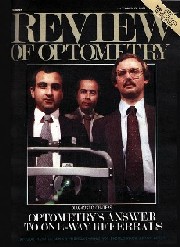
Q: Review of Optometrys cover story in October 1984, Diagnostic Centers: Optometrys Answer to One-Way Referrals, introduced the concept of optometric referral and comanagement centers in a very visible way. Why was there a need for this type of practice back then?
A: At that time, believe it or not, O.D.s had few diagnostic and therapeutic privileges, so they had to refer many patients to their M.D. colleagues. Problemsranging from pink eye to suspected retinal detachment to cataractsall had to be sent to someone else. Odds were that the doctor of optometry might never see the patient again. The patients family members and friends would also disappear, and O.D.s practices shrank while ophthalmologists got busier and busier.
 |
| In 1984, one-way referrals were common. |
The early comanagement centers success was dependent on the ability of the local O.D.s to steer patients outside of their immediate practice area to the center of their choice. They did this admirably, exercising true patient control by sending them to the best surgeons, wherever those surgeons were located. In the process, O.D.s recognized that it was actually better to send the patient to a surgeon further away if the skills of the local surgeon were not as good. The benefit: Patients would get the best care and continue to see their primary-care eye doctor.
Q: What is the status of these comanagement centers today? Is there still a need for them?
A: Fast forward to 2006. Many ophthalmologists now boast about their great working relationship with optometry. The good news: In many instances, that is truly the case. The bad news: The relationship is sometimes only skin deep. Many of these M.D.s never support scope expansion or any issue that helps optometry. Too many of these M.D.s are still quick to criticize the care provided by the O.D., instilling doubt in the patients mind about whether to return to the O.D. for care. More than ever, we need comanagement centers in which ophthalmologists work closely with optometrists.
The future is in our hands. We are primary-care doctors of optometry, and we need to act like it. Primary-care doctors give advice on where patients should be referred; they dont ask patients how far they are willing to travel or whom they would like to see.
Primary-care doctors send their patients to other doctors who support their decisions and their profession at all levels, and monitor whether the specialist they send to walks the walk, not just talks the talk.
Primary-care eye doctors treat everything they canfrom red eye to glaucoma to foreign bodies. But when they do refer, primary care doctors expect their patients to be sent back with a meaningful letter and that the patients feel positive about returning to them.
New graduates and young doctors especially need to know that the comanagement arrangement wasnt always as it is now. As a former medical director of our center put it, Now that the sharks are out of the water, its easy to jump in the pool. Watch out for the sharks, and if you see one that bites, swim somewhere else!

